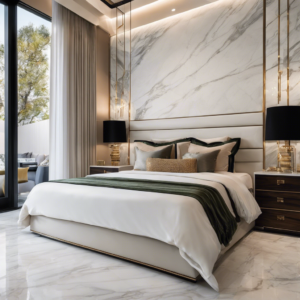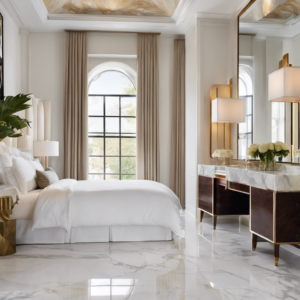Arabascato Slab Stone, also known as “Angel Tears”, is a type of marble. This beautiful and luxurious stone is highly sought after in the construction industry due to its unique pattern and color, as well as its desirable technical characteristics. Arabascato Marble Stone Specifications Arabascato, a renowned and highly sought-after white patterned stone among contemporary […]
Arabascato Slab Stone, also known as “Angel Tears”, is a type of marble. This beautiful and luxurious stone is highly sought after in the construction industry due to its unique pattern and color, as well as its desirable technical characteristics.
Arabascato, a renowned and highly sought-after white patterned stone among contemporary architects and designers, originates from Italy and is primarily processed into slabs. The irregular gray and black veins and lines on its white background create a captivating and visually striking pattern. Its crystalline and translucent nature, coupled with high polishability, endows it with excellent light reflection properties. This characteristic makes it ideal for brightening up dimly lit areas within a building.
White or light cream background with fine, irregular veins of black, gray, brown, and sometimes gold.
Resembling angel wings or clouds.
Polished and shiny after processing.
Water Absorption: Relatively low (due to high density)
Abrasion Resistance: Good
Compressive Strength: Good
Polishing Capability: Excellent (capable of creating a shiny, mirror-like surface)
Arabescato Marble has a unique and attractive appearance, and it creates a luxurious and cozy atmosphere. Moreover, it offers good resistance to abrasion and impact. Additionally, its high polishability results in a shiny surface. Some varieties even have light transmission capability, enhancing their aesthetic appeal.
Relatively high price
Possibility of color change if exposed to direct sunlight for a long time (in some varieties)
Possibility of staining if nano-sealants are not used
Use resin and epoxy in humid environments to prevent water penetration.

Often used for kitchen countertops and bathroom vanity tops, Arabescato Marble adds a touch of luxury to these spaces. Its distinctive veining and white background create a timeless and upscale aesthetic.
Ideal for areas with moderate foot traffic, Arabescato Marble flooring creates a visually stunning and elegant look in entryways, foyers, living rooms, and bedrooms. Proper sealing and maintenance are essential to protect it from potential damage.
Using Arabescato Marble for wall cladding can create a striking focal point. It is perfect for feature walls, fireplace surrounds, and bathroom or shower accents. The marble’s veining patterns add depth and visual interest to the overall design.
Arabescato Marble can be used as decorative accents in the form of mosaic tiles, borders, or trim pieces. These accents can be incorporated into backsplashes, shower niches, or other areas where a touch of elegance is desired.
The natural beauty and heat resistance of Arabescato Marble make it well-suited for fireplace surrounds, creating a stunning focal point and enhancing the ambiance of a living room or sitting area.
Arabescato Marble is porous and needs regular sealing to prevent stains and moisture absorption. A high-quality, penetrating sealer should be applied, following the manufacturer’s instructions.
Use a pH-neutral, non-abrasive cleaner specifically formulated for marble. Avoid harsh or acidic cleaners that can etch or damage the stone. Clean with a soft cloth or mop, rinse thoroughly, and dry with a soft cloth.
While durable, Arabescato Marble can still be scratched by abrasive materials. Avoid dragging heavy objects across the surface and use coasters or placemats under potentially abrasive items.
Although heat-resistant, it’s advisable to use trivets or hot pads under hot pots and pans to prevent thermal shock and potential damage.
Dust the surfaces frequently with a soft, microfiber cloth or dust mop to prevent scratching.
Do not allow water or other liquids to pool on the surface for extended periods. Wipe up spills immediately to prevent absorption and staining.
Over time, the polished surface may lose some of its luster. Periodic polishing can restore shine and enhance the marble’s natural beauty.

Clarity and Cracks: Inspect for visible cracks or structural flaws. While minor natural variations are normal, excessive cracks indicate lower quality.
Thickness and Uniformity: Consistent thickness ensures stability and ease of installation. Moreover, uniform thickness contributes to the marble’s durability.
Finishing Quality: A polished finish should be reflective and glossy, showcasing the marble’s beauty. Therefore, ensure the finish enhances the stone’s natural elegance.
Source and Reputation: Choose reputable suppliers with a track record of providing high-quality marble. Consequently, this ensures you receive a premium product.